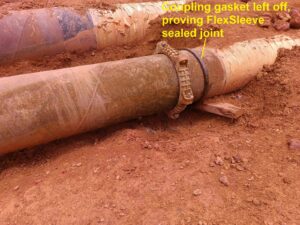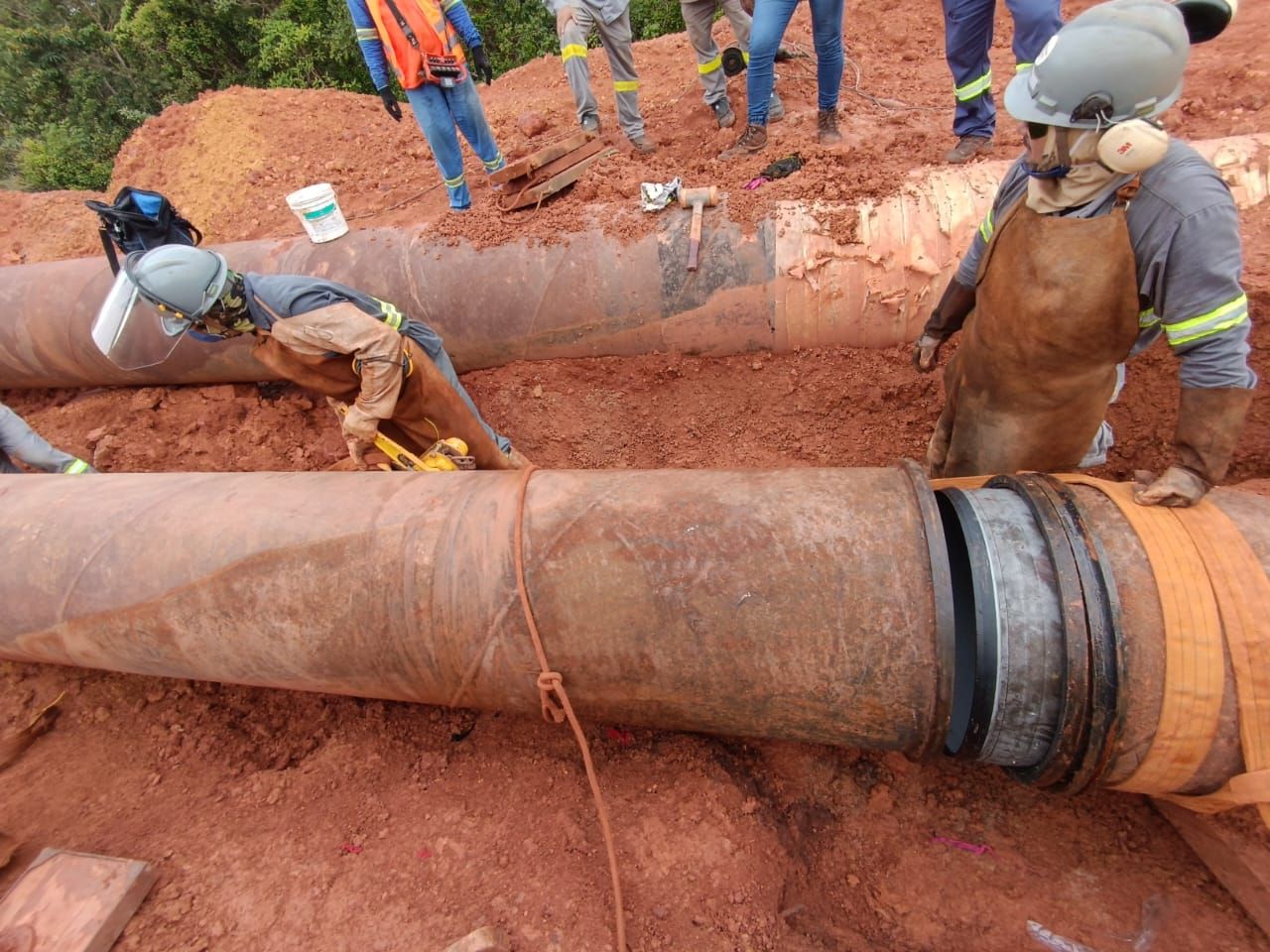When it comes to pipe integrity, ensuring a secure and leak-free connection is paramount. Mechanical joints, a popular choice for pipe connections, offer a fast and efficient installation method. However, even these seemingly robust connections can develop leaks, leading to costly downtime and repairs. This is where FlexSleeve steps in, showcasing its potential beyond its traditional role in corrosion protection.
In this blog, we will explore the unexpected hero – FlexSleeve – and its successful application in sealing a leaky mechanical joint in a Brazilian water pipeline project. We’ll delve into the world of mechanical joints, explore the challenges of leaks, and demonstrate how FlexSleeve emerged as a surprising yet effective solution.
What is Mechanical Joint?
Mechanical joints, also known as bolted or clamped joints, are widely used in various piping systems due to their ease of installation and disassembly. They consist of several components, including:
- Pipe ends: These prepped ends of the pipes are designed to fit together precisely.
- Gaskets: These compressible seals create a watertight barrier between the pipe ends.
- Clamping mechanism: This mechanism, typically bolts or clamps, applies pressure to the joint, ensuring a tight and secure connection.
Benefits of Mechanical Joints
- Fast and Easy Installation: Compared to welding, mechanical joints require minimal tools and skilled labor, leading to faster installation times. This translates to cost savings and reduced project timelines.
- Reusability: Unlike welded joints, mechanical joints can be disassembled and reused, making them ideal for temporary or frequently serviced pipelines.
- Accommodates Movement: Certain mechanical joint designs offer some flexibility, allowing for slight pipe movement due to thermal expansion or contraction.
Furthermore, we suggest reading out “30-50% of US Drinking Water Lost to Leaks: How LPS Can Help.”
Types of Mechanical Joints
There are various types of mechanical joints available, each with its own design and application:
- Flange Joints: These consist of flanged pipe ends bolted together with a gasket in between. They are commonly used in high-pressure applications.
- Compression Joints: These joints utilize a compressible ring or sleeve that is tightened around the pipe ends to create a seal.
- Grip Joints: These joints employ a clamping mechanism that grips the pipe ends together, often with a gasket for added sealing.
Additionally, we suggest reading out “Pipe Sleeve / Insert Sleeve for Internally Coated Steel Pipe.”
Leaky Mechanical Joints in a Brazilian Water Pipeline Project


A newly constructed water pipeline in Brazil encountered a critical hurdle during a hydrostatic pressure test – leaks emanating from the mechanical joints. This unexpected setback threatened to delay the project and incur significant costs for repairs. The contractor, faced with a time-sensitive situation, contacted Lined Pipe Systems(LPS) for a solution.
FlexSleeve
FlexSleeve, primarily known for its exceptional performance in preventing corrosion under insulation (CUI) in pipe joints, entered the scene as a potential solution. Traditionally, FlexSleeve is a heat-shrinkable sleeve that bonds to the pipe surface, creating a barrier against moisture ingress and subsequent corrosion.
The ingenious idea was to test FlexSleeve’s sealing capabilities on the leaky mechanical joints. Here’s how it unfolded:
- The Experiment: To assess FlexSleeve’s effectiveness, the contractor connected the mechanical coupling without the external gasket, which is typically responsible for sealing the joint from the outside.
- The Result: Remarkably, FlexSleeve successfully sealed the leak entirely. The pipeline passed the hydrostatic pressure test, demonstrating FlexSleeve’s potential as a reliable sealant for mechanical joints.
This unexpected success story highlights FlexSleeve’s versatility and its ability to extend beyond its primary function of corrosion protection. It showcases the power of innovative thinking and exploring alternative solutions when faced with unforeseen challenges.
Additionally, we suggest reading out “Revolutionize Pipeline Construction: Faster, Safer, Lower-Risk with Internally Coated Sleeves.”
Benefits of Using FlexSleeve for Sealing Leaky Mechanical Joints
The successful application of FlexSleeve in the Brazilian water pipeline project presents several advantages:
- Quick and Easy Leak Repair: Compared to traditional repair methods that might involve replacing the joint or gasket, FlexSleeve offers a faster and less labor-intensive solution.
- Cost-Effective: FlexSleeve can potentially save time and resources associated with extensive repairs or replacements.
- Reliable Seal: The Brazilian project demonstrated FlexSleeve’s effectiveness in achieving a leak-proof seal, ensuring pipeline integrity.
- Minimal Disruption: Applying FlexSleeve requires minimal disassembly of the joint, minimizing downtime and disruption to the pipeline operation.
- Versatility: This case study broadens the scope of FlexSleeve’s applications, showcasing its potential beyond corrosion protection.
FlexSleeve: A Valuable Addition to Your Leak Repair Solutions
The Brazilian water pipeline project serves as a testament to FlexSleeve’s potential beyond corrosion protection. Its ability to effectively seal leaks in mechanical joints offers a valuable alternative to traditional leak repair methods. By considering the factors mentioned above and consulting with LPS, you can determine if FlexSleeve is the right solution for your leaky mechanical joint woes.
Beyond the Case Study: Expanding the Applications of FlexSleeve
The successful use of FlexSleeve in sealing leaks opens doors to exploring its potential in various applications:
- Emergency Leak Repair: FlexSleeve’s quick and easy application makes it a suitable solution for temporary leak repairs until a permanent fix can be implemented.
- Preventative Maintenance: Considering FlexSleeve as a preventative measure on critical mechanical joints in high-risk areas might be a proactive approach to avoid future leaks.
- Underground Pipelines: FlexSleeve’s ability to form a watertight seal can be beneficial for underground pipelines where access for repairs might be limited.
Further research and development might unlock even more possibilities for FlexSleeve’s application in the realm of pipe joint sealing and leak prevention.
Conclusion
FlexSleeve’s story transcends its role as a corrosion protection solution. The Brazilian water pipeline project serves as a compelling example of its potential in addressing unforeseen challenges like leaky mechanical joints. By embracing innovative solutions and exploring alternative applications, FlexSleeve can play a significant role in ensuring the integrity and efficient operation of piping systems across various industries.
Therefore, if you’re facing challenges with leaky mechanical joints, consider FlexSleeve as a potential solution. Contact Lined Pipe Systems to discuss your specific needs and explore if FlexSleeve can be the answer to your leak woes.
Feel free to share your thoughts or experiences with FlexSleeve in the comments section below.





